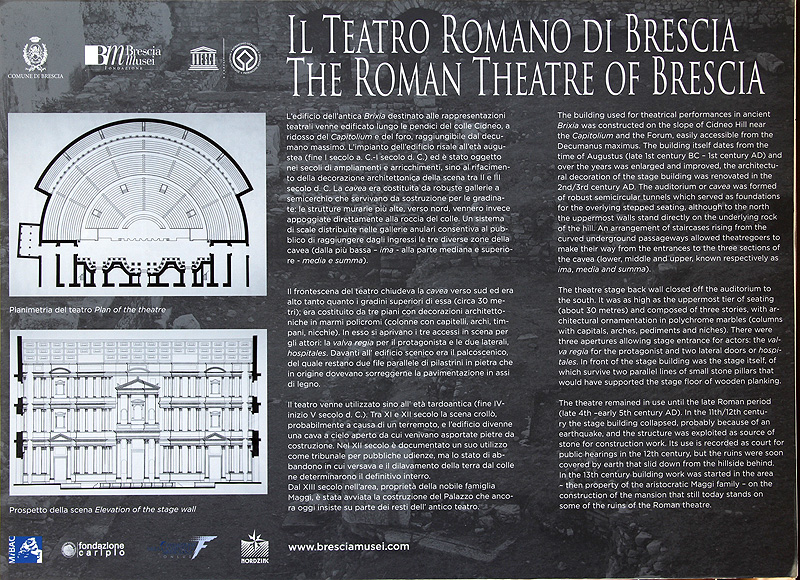
• Photos and Panorama Movies • Theatre Archive Home • Glossary of Terms 
From: Brixia Archiological Site at Brescia (Brixia), Italy. 2015.
| Brixia Roman Theatre, Modern Brescia, Italy.
The building used for theatrical performances in ancient Brixia was constructed on the slope of Cidneo Hill near the Capitolium and the Forum, easily accessible from the Decumanus maximus. The building itself dates from the time of Augustus (late 1st century BC - 1st century AD) and over the years was enlarged and improved, the architectural decoration of the stage building was renovated in the 2nd/3rd century AD. The auditorium or cavea was formed of robust semicircular tunnels which served as foundations for the overlying stepped seating, although to the north the uppermost walls stand directly on the underlying rock of the hill. An arrangement of staircases rising from the curved underground passageways allowed theatregoers to make their way from the entrances to the three sections of the cavea (lower, middle and upper, known respectively as ima, media and summa). The theatre stage back wall closed off the auditorium to the south. It was as high as the uppermost tier of seating (about 30 metres) and composed of three stories, with architectural ornamentation in polychrome marbles (columns with capitals, arches, pediments and niches). There were three apertures allowing stage entrance for actors: the valva regia for the protagonist and two lateral doors or hospitales. In front of the stage building was the stage itself, of which survive two parallel lines of small stone pillars that would have supported the stage floor of wooden planking. The theatre remained in use until the late Roman period (late 4th -early 5th century AD). In the 11th/12th century the stage building collapsed, probably because of an earthquake, and the structure was exploited as source of stone for construction work. Its use is recorded as court for public hearings in the 12th century, but the ruins were soon covered by earth that slid down from the hillside behind. In the 13th century building work was started in the area - then property of the aristocratic Maggi family - on the construction of the mansion that still today stands on some of the ruins of the Roman theatre. |
|
|
|
|
|
|
- Copyright © 2003 Thomas G. Hines, Department of Theatre, Whitman College. All Rights Reserved. The Ancient Theatre Archive is a non-profit, educational project, located at Whitman College, USA. Research and Publication Partially Funded Through Grants from Whitman College, The United States Institute for Theatre Technology, and The National Endowment for the Humanities.
- © This website is copyright protected. Pages may be downloaded, printed, copied, and distributed as long as they remain unchanged and The Ancient Theatre Archive is given due credit.Last Update 3/25/2009.